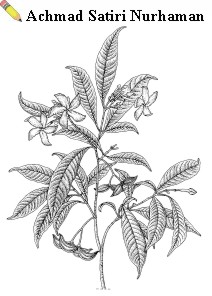Record Number
1326
PROSEA Handbook Number
12(2): Medicinal and poisonous plants 2
Taxon
Tabernaemontana pandacaqui Poir.
This article should be read together with the article on the genus: Tabernaemontana in the Handbook volume indicated above in this database.
This article should be read together with the article on the genus: Tabernaemontana in the Handbook volume indicated above in this database.
Protologue
in Lamarck, Encycl. 7: 529 (1806).
Synonyms
Tabernaemontana orientalis R.Br. (1810), Tabernaemontana cumingiana A.DC. (1844), Ervatamia pandacaqui (Poir.) Pichon (1949).
Vernacular Names
Papua New Guinea: oru (Hulu, Central Province), karaban (Nyamikum, Sepik). Philippines: kampupot (Tagalog), pandakaki (Tagalog, Bisaya, Pampangan). Thailand: put farang (Bangkok), phut tum (northern).
Distribution
From Thailand and southern Taiwan throughout the Philippines to Sabah, from East Java and Sulawesi eastward throughout New Guinea into the Pacific and northern and eastern Australia.
Uses
In the Philippines a poultice of the leaves is applied as an emmenagogue and to hasten parturition. A decoction of the leaves is added to the bath of women after parturition. A decoction of the root and bark is taken to relieve affections of the stomach and intestines. The latex is applied as an emollient to bruises and wounds, and to swellings. In Thailand, the roots are used as an antidiarrhoeal. In Papua New Guinea, the root is scraped and rubbed onto a sore nose. Sap from the ripe fruit is applied to skin affected by ringworm (Tinea imbricata). In Fiji, a poultice of the plant is used to reduce swellings and abscesses.
Observations
A shrub or small tree, 1—14 m tall, trunk up to 20 cm in diameter; leaves elliptical to narrowly elliptical, (1.5—)3—25 cm x (0.4—)1—10 cm, 1.7—4(7) times longer than wide, apex obtuse or sometimes rounded, secondary veins usually pale green on both sides, petiole 3—20 mm long; inflorescence rather lax or more or less congested, 3—11 cm x 3—16 cm, 1—many-flowered; flowers slightly scented or not, open during the day, sepals pale green, corolla in mature bud 10—31 mm long with a comparatively wide subglobose or mostly broadly ovoid head for 15—40% of the length, apex blunt or rounded, tube 3.7—11 times longer than the calyx, 8—22 mm long, twisted 0.25—0.5 turn or not just below the anthers; fruit consisting of 2 separate mericarps, obliquely ellipsoid or less often subglobose, with 1 adaxial and 1—2 lateral ridges or wings, orange, red or yellow, 2—40-seeded. Tabernaemontana pandacaqui is found in forest or bush, often on limestone from sea-level to 1800 m altitude. It flowers and fruits throughout the year. In the Philippines flowering peaks in March—June and fruiting in September—November; in Papua New Guinea flowering peaks in March and November—December and fruiting in January and September.
Image
 | Tabernaemontana pandacaqui Poir. - flowering and fruiting branch |
Selected Sources
[128] Brown, W.H., 1951—1957. Useful plants of the Philippines. Reprint of the 1941—1943 edition. 3 volumes. Technical Bulletin 10. Department of Agriculture and Natural Resources. Bureau of Printing, Manila, the Philippines. Vol. 1 (1951) 590 pp
[241] de Padua, L.S., Lugod, G.C. & Pancho, J.V., 1977—1983. Handbook on Philippine medicinal plants. 4 volumes. Documentation and Information Section, Office of the Director of Research, University of the Philippines at Los Baños, the Philippines.
[317] Forster, P.I., 1992. Circumscription of Tabernaemontana pandacaqui (Apocynaceae) in Australia. Australian Systematic Botany 5(5): 521—531.
[380] Gutierrez, H.G., 1980—1982. An illustrated manual of Philippine materia medica. 2 volumes. Natural Research Council of the Philippines, Tagig, Metro Manila, the Philippines. Vol. 1 (1980) pp. 1—234, Vol. 2 (1982) pp. 235—485.
[418] Holdsworth, D.K., 1977. Medicinal plants of Papua New Guinea. Technical Paper No 175. South Pacific Commission, Noumea, New Caledonia. 123 pp.
[672] Middleton, D.J., 1999. Apocynaceae. In: Santisuk, T. & Larsen, K. (Editors). Flora of Thailand. Vol. 7(1). The Forest Herbarium, Royal Forest Department, Bangkok, Thailand. pp. 1—153.
[758] Okuyama, E., Gao, L.H. & Yamazaki, M., 1992. Analgesic components from Bornean medicinal plants Tabernaemontana pauciflora Blume and Tabernaemontana pandacaqui Poir. Chemical and Pharmaceutical Bulletin (Tokyo) 40(8): 2075—2079.
[786] Perry, L.M., 1980. Medicinal plants of East and Southeast Asia. Attributed properties and uses. MIT Press, Cambridge, Massachusetts, United States & London, United Kingdom. 620 pp.
[810] Quisumbing, E., 1978. Medicinal plants of the Philippines. Katha Publishing Co., Quezon City, the Philippines. 1262 pp.
[241] de Padua, L.S., Lugod, G.C. & Pancho, J.V., 1977—1983. Handbook on Philippine medicinal plants. 4 volumes. Documentation and Information Section, Office of the Director of Research, University of the Philippines at Los Baños, the Philippines.
[317] Forster, P.I., 1992. Circumscription of Tabernaemontana pandacaqui (Apocynaceae) in Australia. Australian Systematic Botany 5(5): 521—531.
[380] Gutierrez, H.G., 1980—1982. An illustrated manual of Philippine materia medica. 2 volumes. Natural Research Council of the Philippines, Tagig, Metro Manila, the Philippines. Vol. 1 (1980) pp. 1—234, Vol. 2 (1982) pp. 235—485.
[418] Holdsworth, D.K., 1977. Medicinal plants of Papua New Guinea. Technical Paper No 175. South Pacific Commission, Noumea, New Caledonia. 123 pp.
[672] Middleton, D.J., 1999. Apocynaceae. In: Santisuk, T. & Larsen, K. (Editors). Flora of Thailand. Vol. 7(1). The Forest Herbarium, Royal Forest Department, Bangkok, Thailand. pp. 1—153.
[758] Okuyama, E., Gao, L.H. & Yamazaki, M., 1992. Analgesic components from Bornean medicinal plants Tabernaemontana pauciflora Blume and Tabernaemontana pandacaqui Poir. Chemical and Pharmaceutical Bulletin (Tokyo) 40(8): 2075—2079.
[786] Perry, L.M., 1980. Medicinal plants of East and Southeast Asia. Attributed properties and uses. MIT Press, Cambridge, Massachusetts, United States & London, United Kingdom. 620 pp.
[810] Quisumbing, E., 1978. Medicinal plants of the Philippines. Katha Publishing Co., Quezon City, the Philippines. 1262 pp.
Author(s)
L.S.L. Chua & S.F.A.J. Horsten
Correct Citation of this Article
Chua, L.S.L & Horsten, S.F.A.J., 2001. Tabernaemontana pandacaqui Poir.. In: van Valkenburg, J.L.C.H. and Bunyapraphatsara, N. (Editors): Plant Resources of South-East Asia No 12(2): Medicinal and poisonous plants 2. PROSEA Foundation, Bogor, Indonesia. Database record: prota4u.org/prosea

All texts are licensed under a Creative Commons Attribution-Noncommercial-Share Alike 3.0 Netherlands License
This license does not include the illustrations (Maps,drawings,pictures); these remain all under copyright.